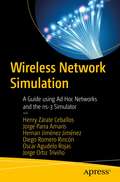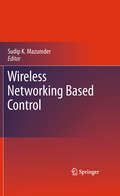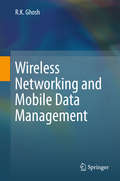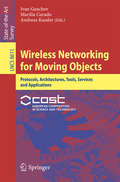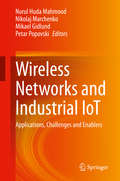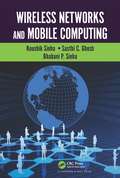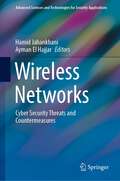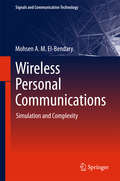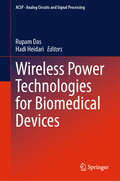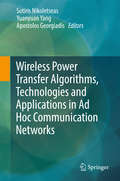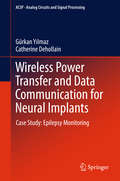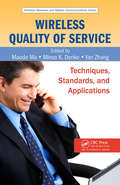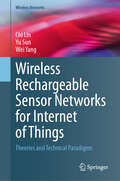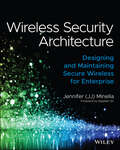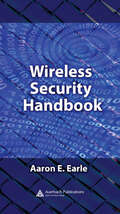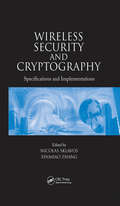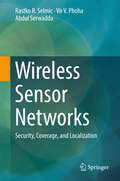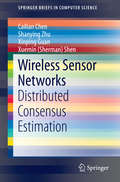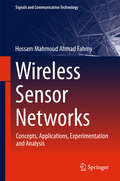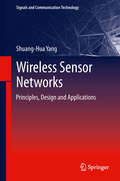- Table View
- List View
Wireless Network Simulation: A Guide using Ad Hoc Networks and the ns-3 Simulator
by Henry Zárate Ceballos Jorge Ernesto Parra Amaris Hernan Jiménez Jiménez Diego Alexis Romero Rincón Oscar Agudelo Rojas Jorge Eduardo Ortiz TriviñoLearn to run your own simulation by working with model analysis, mathematical background, simulation output data, and most importantly, a network simulator for wireless technology. This book introduces the best practices of simulator use, the techniques for analyzing simulations with artificial agents and the integration with other technologies such as Power Line Communications (PLC).Network simulation is a key technique used to test the future behavior of a network. It’s a vital development component for the development of 5G, IoT, wireless sensor networks, and many more. This book explains the scope and evolution of the technology that has led to the development of dynamic systems such as Internet of Things and fog computing. You'll focus on the ad hoc networks with stochastic behavior and dynamic nature, and the ns-3 simulator. These are useful open source tools for academics, researchers, students and engineers to deploy telecommunications experiments, proofs and new scenarios with a high degree of similarity with reality. You'll also benefit from a detailed explanation of the examples and the theoretical components needed to deploy wireless simulations or wired, if necessary.What You’ll LearnReview best practices of simulator usesUnderstand techniques for analyzing simulations with artificial agentsApply simulation techniques and experiment designProgram on ns-3 simulatorAnalyze simulation resultsCreate new modules or protocols for wired and wireless networksWho This Book Is ForUndergraduate and postgraduate students, researchers and professors interested in network simulations. This book also includes theoretical components about simulation, which are useful for those interested in discrete event simulation DES, general theory of simulation, wireless simulation and ns-3 simulator.
Wireless Networked Music Performance
by Leonardo Gabrielli Stefano SquartiniThisbook presents a comprehensive overview of the state of the art in NetworkedMusic Performance (NMP) and a historical survey of computer music networking. It introduces current technical trends in NMP and technical issues yet to beaddressed. It also lists wireless communication protocols and compares these to the requirements of NMP. Practicaluse cases and advancements are also discussed.
Wireless Networking Based Control
by Sudip K. MazumderThis book will have a broad appeal in the area of Wireless Networking-Based Control. Various engineering disciplines, control and communication science organizations will be interested in purchasing the book with a new, emerging, and important theme. Also, industry such as Honeywell and those (e.g. power industry, automotive industry, aerospace industry) interested in implementing wireless network control to express interest in purchasing this book.
Wireless Networking Principles: From Terrestrial to Underwater Acoustic
by Shengming JiangThis book systematically summarizes the fundamentals and various technologies in both terrestrial radio wireless networks and underwater acoustic networks (UWANs). It addresses the basic issues frequently investigated in terrestrial radio wireless networks and the key technologies suitable for the newly developing research area of UWANs. Starting with a review of our current understanding of wireless networks, it then introduces the principles of the main technologies, including error control, medium access control (MAC) protocols, routing protocols, end-to-end transmission control and mobility issues as well as network security for terrestrial radio wireless networks, and offers detailed surveys of these technologies for UWANs.Providing readers with the basic knowledge of terrestrial radio wireless networking technologies and raising readers’ awareness of the developing topic of UWANs in ocean , it is a valuable resource for researchers and practitioners in terrestrial radio wireless networks and UWANs.
Wireless Networking and Mobile Data Management
by R. K. GhoshThis book examines two main topics, namely, Wireless Networking and Mobile Data Management. It is designed around a course the author began teaching to senior undergraduate and master's students at the Department of Computer Science & Engineering of the Indian Institute of Technology Kanpur. The first part of the book, consisting of eight chapters, including the introduction, focuses exclusively on wireless networking aspects. It begins with cellular communication systems, which provided the foundation of wireless networking principles. Three subsequent chapters are devoted to the Global System for Mobile communication (GSM), Wireless Local Area Network (WLAN), Bluetooth, infrared (IR), ZigBee and 6LoWPAN protocols. There is also a chapter on routings in ad hoc networks, an area that is currently being intensively researched due to its potential applications in areas of vehicular network, traffic management, tactical and military systems. Furthermore, the book discusses mobile operating systems and wireless network application level protocols such as Wireless Application Protocols (WAP), Mobile IP and Mosh. The second part highlights mobile data management. It addresses the issues like location management, the importance of replication and caching in mobile environments, the concept of broadcast disk and indexing in air, storage systems for sharing data in mobile environments, and building smart environments. Given that the design of algorithms is the key to applications in data management; this part begins with a chapter on the type of paradigm shift that has been introduced in the design of algorithms, especially due to asymmetry in mobile environments. Lastly, the closing chapter of the book explores smart environments, showing the readers how wireless technology and mobile data management can be combined to provide optimum comfort for human life. Though the book has been structured as a monograph, it can be used both as a textbook and as a reference material for researchers and developers working in the area.
Wireless Networking for Moving Objects: Protocols, Architectures, Tools, Services and Applications (Lecture Notes in Computer Science #8611)
by Ivan Ganchev, Marília Curado and Andreas KasslerWireless networks of moving objects have drawn significant attention recently. These types of networks consist of a number of autonomous or semi-autonomous wireless nodes/objects moving with diverse patterns and speeds while communicating via several radio interfaces simultaneously. To overcome current shortcomings, a number of research challenges have to be addressed in this area, ranging from initial conceptualization and modelling, to protocols and architectures engineering, and development of suitable tools, applications and services, and to the elaboration of realistic use-case scenarios by taking into account corresponding societal and economic aspects. By applying a systematic approach the objective of this book is to assess the state of the art and consolidate the main research results achieved in this area. It was prepared as the Final Publication of the COST Action IC0906 “Wireless Networking for Moving Objects (WiNeMO)”. The book contains 15 chapters and is a show-case of the main outcomes of the action in line with its scientific goals. The book will serve as a valuable reference for undergraduate students, post-graduate students, educators, faculty members, researchers, engineers, and research strategists working in this field.
Wireless Networks and Industrial IoT: Applications, Challenges and Enablers
by Petar Popovski Nurul Huda Mahmood Nikolaj Marchenko Mikael GidlundThis book provides a comprehensive overview of the most relevant research and standardization results in the area of wireless networking for Industrial IoT, covering both critical and massive connectivity. Most chapters in this book are intended to serve as short tutorials of particular topics, highlighting the main developments and ideas, as well as giving an outlook of the upcoming research challenges.The book is divided into four parts. The first part focuses on challenges, enablers and standardization efforts for reliable low-latency communication in Industrial IoT networks. The next part focuses on massive IoT, which requires cost- and energy-efficient technology components to efficiently connect a massive number of low-cost IoT devices. The third part covers three enabling technologies in the context of Industrial IoT: Security, Machine Learning/Artificial Intelligence and Edge Computing. These enablers are applicable to both connectivity types, critical and massive IoT. The last part covers aspects of Industrial IoT related to connected transportation that are important in, for example, warehouse and port logistics, product delivery and transportation among industries.Presents a comprehensive guide to concepts and research challenges in wireless networking for Industrial IoT;Includes an introduction and overview of such topics as 3GPP standardization for Industrial IoT, Time Sensitive Networking, system dependability over wireless networks, energy-efficient wireless networks, IoT security, ML/AI for Industrial IoT and connected transportation systems;Features contributions by well-recognized experts from both academia and industry.
Wireless Networks and Mobile Computing
by Koushik Sinha Sasthi C. Ghosh Bhabani P. SinhaWireless communication is one of the fastest growing industry segments today. Many types of wireless networks are now being used for applications such as personal communication, entertainment, rural and urban healthcare, smart home building, inventory control, and surveillance. This book introduces the basic concepts of wireless networks and mobile
Wireless Networks: Cyber Security Threats and Countermeasures (Advanced Sciences and Technologies for Security Applications)
by Hamid Jahankhani Ayman El HajjarIn recent years, wireless networks communication has become the fundamental basis of our work, leisure, and communication life from the early GSM mobile phones to the Internet of Things and Internet of Everything communications. All wireless communications technologies such as Bluetooth, NFC, wireless sensors, wireless LANs, ZigBee, GSM, and others have their own challenges and security threats. This book addresses some of these challenges focusing on the implication, impact, and mitigations of the stated issues. The book provides a comprehensive coverage of not only the technical and ethical issues presented by the use of wireless networks but also the adversarial application of wireless networks and its associated implications. The authors recommend a number of novel approaches to assist in better detecting, thwarting, and addressing wireless challenges and threats. The book also looks ahead and forecasts what attacks can be carried out in the future through the malicious use of the wireless networks if sufficient defenses are not implemented. The research contained in the book fits well into the larger body of work on various aspects of wireless networks and cyber-security. The book provides a valuable reference for cyber-security experts, practitioners, and network security professionals, particularly those interested in the security of the various wireless networks. It is also aimed at researchers seeking to obtain a more profound knowledge in various types of wireless networks in the context of cyber-security, wireless networks, and cybercrime. Furthermore, the book is an exceptional advanced text for Ph.D. and master’s degree programs in cyber-security, network security, cyber-terrorism, and computer science who are investigating or evaluating a security of a specific wireless network. Each chapter is written by an internationally-renowned expert who has extensive experience in law enforcement, industry, or academia. Furthermore, this book blends advanced research findings with practice-based methods to provide the reader with advanced understanding and relevant skills.
Wireless Personal Communications: Simulation And Complexity (Signals And Communication Technology)
by Mohsen A. M. El-BendaryThis book introduces wireless personal communications from the point of view of wireless communication system researchers. Existing sources on wireless communications put more emphasis on simulation and fundamental principles of how to build a study model. In this volume, the aim is to pass on to readers as much knowledge as is essential for completing model building of wireless communications, focusing on wireless personal area networks (WPANs). This book is the first of its kind that gives step-by-step details on how to build the WPANs simulation model. It is most helpful for readers to get a clear picture of the whole wireless simulation model by being presented with many study models. The book is also the first treatise on wireless communication that gives a comprehensive introduction to data-length complexity and the computational complexity of the processed data and the error control schemes. This volume is useful for all academic and technical staff in the fields of telecommunications and wireless communications, as it presents many scenarios for enhancing techniques for weak error control performance and other scenarios for complexity reduction of the wireless data and image transmission. Many examples are given to help readers to understand the material covered in the book. Additional resources such as the MATLAB codes for some of the examples also are presented.
Wireless Power Technologies for Biomedical Devices (Analog Circuits and Signal Processing)
by Hadi Heidari Rupam DasDiscover ground-breaking advancements in wireless biomedical device technology with our comprehensive book, which delves into the latest innovations revolutionizing Healthcare Chapter 1 introduces wireless power transfer (WPT) techniques, offering a solution to the frequent battery replacements required by cardiovascular implantable medical devices (cIMDs). Explore how WPT holds the promise of long-term functionality for these life-saving devices, ushering in an era of more efficient and convenient healthcare solutions. In Chapter 2, explore the world of energy harvesting for cardiovascular implants. From Triboelectric Nanogenerators (TENG) to Biofuel cells, discover how self-powering devices are reshaping the landscape of cardiovascular healthcare, reducing the need for battery replacements, and enhancing patient convenience. Chapter 3 unveils the potential of magnetoelectric composites in wireless power transfer for biomedical applications, while Chapter 4 sheds light on the competency of Triboelectric Nanogenerators in wireless device applications, offering a sustainable alternative to traditional batteries. Chapter 5 showcases the promise of photovoltaic energy scavenging for implantable medical devices, highlighting its potential to revolutionize healthcare with higher-power conversion efficiencies and smaller form factors. Explore the realm of ultrasound-based wireless powering technologies in Chapter 6, offering insights into the physics of acoustic powering and the design considerations for ultrasonically powered devices. Chapter 7 ventures into the realm of smart contact lenses, discussing their transformative potential in healthcare, augmented reality, and personalized computing. In Chapter 8, dive into the research gap for Single Input, Single-Output (SISO) state-of-the-art biomedical devices, exploring the challenges and opportunities in charge pump converters and multi-output converters. Finally, Chapter 9 explores power management integrated circuits for implantable devices, focusing on energy efficiency and optimal power usage to prolong device life and minimize power loss. With contributions from leading experts in the field, this book is an indispensable resource for researchers, engineers, and healthcare professionals alike, shaping the future of implantable medical devices and advancing patient care worldwide.
Wireless Power Transfer Algorithms, Technologies and Applications in Ad Hoc Communication Networks
by Apostolos Georgiadis Yuanyuan Yang Sotiris NikoletseasThis book is the first systematic exposition on the emerging domain of wireless power transfer in ad hoc communication networks. It selectively spans a coherent, large spectrum of fundamental aspects of wireless power transfer, such as mobility management in the network, combined wireless power and information transfer, energy flow among network devices, joint activities with wireless power transfer (routing, data gathering and solar energy harvesting), and safety provisioning through electromagnetic radiation control, as well as fundamental and novel circuits and technologies enabling the wide application of wireless powering. Comprising a total of 27 chapters, contributed by leading experts, the content is organized into six thematic sections: technologies, communication, mobility, energy flow, joint operations, and electromagnetic radiation awareness. It will be valuable for researchers, engineers, educators, and students, and it may also be used as a supplement to academic courses on algorithmic applications, wireless protocols, distributed computing, and networking.
Wireless Power Transfer and Data Communication for Neural Implants
by Catherine Dehollain Gürkan YilmazThis book presents new circuits and systems for implantable biomedical applications targeting neural recording. The authors describe a system design adapted to conform to the requirements of an epilepsy monitoring system. Throughout the book, these requirements are reflected in terms of implant size, power consumption, and data rate. In addition to theoretical background which explains the relevant technical challenges, the authors provide practical, step-by-step solutions to these problems. Readers will gain understanding of the numerical values in such a system, enabling projections for feasibility of new projects.
Wireless Quality of Service: Techniques, Standards, and Applications
by Maode Ma Yan Zhang Mieso K. DenkoFocusing on an important and complicated topic in wireless network design, Wireless Quality of Service: Techniques, Standards, and Applications systematically addresses the quality-of-service (QoS) issues found in many types of popular wireless networks.In each chapter, the book presents numerous QoS challenges encountered in real-world
Wireless Rechargeable Sensor Networks for Internet of Things: Theories and Technical Paradigms (Wireless Networks)
by Yu Sun Wei Yang Chi LinIn traditional Internet of Things (IoT) systems, sensor nodes are usually powered by batteries, and their limited battery power leads to limited system lifetimes and prevents the large-scale promotion of IoT; this is commonly referred to as the energy bottleneck. The subsequent emergence of Wireless Power Transmission (WPT) technology enables IoT nodes to replenish their energy through wireless charging, giving rise to the novel network paradigm of Wireless Rechargeable Sensor Networks (WRSNs). This has made it possible to solve the IoT energy bottleneck and extend IoT system lifetimes. This book elaborates on the theory and technical paradigms of WRSNs. The topics discussed include the energy efficiency, schedulability and reliability of WRSNs, as well as their potential intersections with other fields. Specifically, this book 1) proposes the theory of optimal scheduling of spatio-temporal correlation power supply for large-scale WRSNs; 2) analyses in depth the shortcomings and hidden risks of existing WRSN hardware and protocols, and proposes the concept of charging attack and the theory of trusted scheduling; and 3) introduces a radio electromagnetic signal propagation model into the design of charging deployment methods in complex environments, revealing a new dimension of charging efficiency optimization. The methods described here will lay the theoretical foundation for extending WRSN lifetimes and provide a new theoretical model for WRSN security and reliability, accelerating the development of these networks from multiple perspectives.
Wireless Security Architecture: Designing and Maintaining Secure Wireless for Enterprise
by Jennifer MinellaReduce organizational cybersecurity risk and build comprehensive WiFi, private cellular, and IOT security solutions Wireless Security Architecture: Designing and Maintaining Secure Wireless for Enterprise offers readers an essential guide to planning, designing, and preserving secure wireless infrastructures. It is a blueprint to a resilient and compliant architecture that responds to regulatory requirements, reduces organizational risk, and conforms to industry best practices. This book emphasizes WiFi security, as well as guidance on private cellular and Internet of Things security. Readers will discover how to move beyond isolated technical certifications and vendor training and put together a coherent network that responds to contemporary security risks. It offers up-to-date coverage—including data published for the first time—of new WPA3 security, Wi-Fi 6E, zero-trust frameworks, and other emerging trends. It also includes: Concrete strategies suitable for organizations of all sizes, from large government agencies to small public and private companies Effective technical resources and real-world sample architectures Explorations of the relationships between security, wireless, and network elements Practical planning templates, guides, and real-world case studies demonstrating application of the included conceptsPerfect for network, wireless, and enterprise security architects, Wireless Security Architecture belongs in the libraries of technical leaders in firms of all sizes and in any industry seeking to build a secure wireless network.
Wireless Security Handbook
by Aaron E. EarleThe Wireless Security Handbook provides a well-rounded overview of wireless network security. It examines wireless from multiple perspectives, including those of an auditor, security architect, and hacker. This wide scope benefits anyone who has to administer, secure, hack, or conduct business on a wireless network. This text tackles wirele
Wireless Security and Cryptography: Specifications and Implementations
by Nicolas Sklavos Xinmiao ZhangAs the use of wireless devices becomes widespread, so does the need for strong and secure transport protocols. Even with this intensified need for securing systems, using cryptography does not seem to be a viable solution due to difficulties in implementation. The security layers of many wireless protocols use outdated encryption algorithms, which have proven unsuitable for hardware usage, particularly with handheld devices. Summarizing key issues involved in achieving desirable performance in security implementations, Wireless Security and Cryptography: Specifications and Implementations focuses on alternative integration approaches for wireless communication security. It gives an overview of the current security layer of wireless protocols and presents the performance characteristics of implementations in both software and hardware. This resource also presents efficient and novel methods to execute security schemes in wireless protocols with high performance. It provides the state of the art research trends in implementations of wireless protocol security for current and future wireless communications. Unique in its coverage of specification and implementation concerns that include hardware design techniques, Wireless Security and Cryptography: Specifications and Implementations provides thorough coverage of wireless network security and recent research directions in the field.
Wireless Sensing: Principles, Techniques and Applications (Wireless Networks)
by Jiannong Cao Yanni YangThis book systematically presents the wireless sensing technology, which has become a promising sensing paradigm in recent years. It includes the introduction of underlying sensing principles, wireless signals, sensing methodologies and enabled applications. Meanwhile, it provides case studies to demonstrate how wireless sensing is applied for representative human and object sensing applications.This book also provides a wireless sensing framework as a guidance to understand and design a wireless sensing system or prototype based on their needs. It also presents a critical investigation of the challenges in achieving wireless sensing in both signal-level and application-level contexts. Accordingly, it summarizes the typical solutions to tackle the related challenges.Researchers and advanced-level students in computer science or electrical engineering working on the design of a wireless system will find this book useful as a reference. Professionals working in the wireless sensing industry will also find this book valuable as a reference tool.
Wireless Sensor Multimedia Networks: Architectures, Protocols, and Applications
by Xiaohong Jiang Mohamed Mostafa A. AzimWireless sensor networks (WSNs) are a special class of ad hoc network in which network nodes composed of tiny sensors pass data such as temperature, pressure, and humidity through the network to a central location. Wireless sensor multimedia networks (WSMNs) are a special category of WSNs in which the sensor nodes are small cameras and microphones
Wireless Sensor Networks
by Vir V. Phoha Rastko R. Selmic Abdul SerwaddaThis book presents a comprehensive overview of wireless sensor networks (WSNs) with an emphasis on security, coverage, and localization. It offers a structural treatment of WSN building blocks including hardware and protocol architectures and also provides a systems-level view of how WSNs operate. These building blocks will allow readers to program specialized applications and conduct research in advanced topics. A brief introductory chapter covers common applications and communication protocols for WSNs. Next, the authors review basic mathematical models such as Voroni diagrams and Delaunay triangulations. Sensor principles, hardware structure, and medium access protocols are examined. Security challenges ranging from defense strategies to network robustness are explored, along with quality of service measures. Finally, this book discusses recent developments and future directions in WSN platforms. Each chapter concludes with classroom-tested exercises that reinforce key concepts. This book is suitable for researchers and for practitioners in industry. Advanced-level students in electrical engineering and computer science will also find the content helpful as a textbook or reference.
Wireless Sensor Networks
by Xuemin Sherman Shen Cailian Chen Shanying Zhu Xinping GuanThis SpringerBrief evaluates the cooperative effort of sensor nodes to accomplish high-level tasks with sensing, data processing and communication. The metrics of network-wide convergence, unbiasedness, consistency and optimality are discussed through network topology, distributed estimation algorithms and consensus strategy. Systematic analysis reveals that proper deployment of sensor nodes and a small number of low-cost relays (without sensing function) can speed up the information fusion and thus improve the estimation capability of wireless sensor networks (WSNs). This brief also investigates the spatial distribution of sensor nodes and basic scalable estimation algorithms, the consensus-based estimation capability for a class of relay assisted sensor networks with asymmetric communication topology, and the problem of filter design for mobile target tracking over WSNs. From the system perspective, the network topology is closely related to the capability and efficiency of network-wide scalable distributed estimation. Wireless Sensor Networks: Distributed Consensus Estimation is a valuable resource for researchers and professionals working in wireless communications, networks and distributed computing. Advanced-level students studying computer science and electrical engineering will also find the content helpful.
Wireless Sensor Networks
by Hossam Mahmoud Ahmad FahmyThisbook focuses on the principles of wireless sensor networks (WSNs), theirapplications, and their analysis tools, with meticulous attention paid todefinitions and terminology. This book presents the adopted technologies andtheir manufacturers in detail, making WSNs tangible for the reader. Inintroductory computer networking books, chapter sequencing follows thebottom-up or top-down architecture of the 7-layer protocol. This bookaddresses subsequent steps in this process, both horizontally and vertically,thus fostering a clearer and deeper understanding through chapters thatelaborate on WSN concepts and issues. With such depth, this book is intended for a wide audience; it ismeant to be a helper and motivator for senior undergraduates, postgraduates,researchers, and practitioners. It lays out important concepts and WSN-relateapplications; uses appropriate literature to back research and practicalissues; and focuses on new trends. Senior undergraduate students can use it tofamiliarize themselves with conceptual foundations and practical projectimplementations. For graduate students and researchers, test beds andsimulators provide vital insights into analysis methods and tools for WSNs. Lastly, in addition to applications and deployment, practitioners will be ableto learn more about WSN manufacturers and components within several platformsand test beds.
Wireless Sensor Networks
by Shuang-Hua YangWireless Sensor Networks presents the latest practical solutions to the design issues presented in wireless-sensor-network-based systems. Novel features of the text, distributed throughout, include workable solutions, demonstration systems and case studies of the design and application of wireless sensor networks (WSNs) based on the first-hand research and development experience of the author, and the chapters on real applications: building fire safety protection; smart home automation; and logistics resource management. Case studies and applications illustrate the practical perspectives of: · sensor node design; · embedded software design; · routing algorithms; · sink node positioning; · co-existence with other wireless systems; · data fusion; · security; · indoor location tracking; · integrating with radio-frequency identification; and · Internet of things Wireless Sensor Networks brings together multiple strands of research in the design of WSNs, mainly from software engineering, electronic engineering, and wireless communication perspectives, into an over-arching examination of the subject, benefiting students, field engineers, system developers and IT professionals. The contents have been well used as the teaching material of a course taught at postgraduate level in several universities making it suitable as an advanced text book and a reference book for final-year undergraduate and postgraduate students.
Wireless Sensor Networks: 12th China Conference, Cwsn 2018 Kunming, China, September 21-23, 2018, Revised Selected Papers (Communications in Computer and Information Science #984)
by Shikai Shen Kaiguo Qian Shaojun Yu Wu WangThis book constitutes the refereed proceedings of the 12th China Conference on Wireless Sensor Networks, CWSN 2018, held in Kunming, China, in September 2018. <P><P> The 16 revised full papers were carefully reviewed and selected from 177 submissions. The papers are organized in topical sections on algorithm for wireless sensor network; positioning and location; neural network; energy efficiency and harvesting; privacy and security; image processing.
